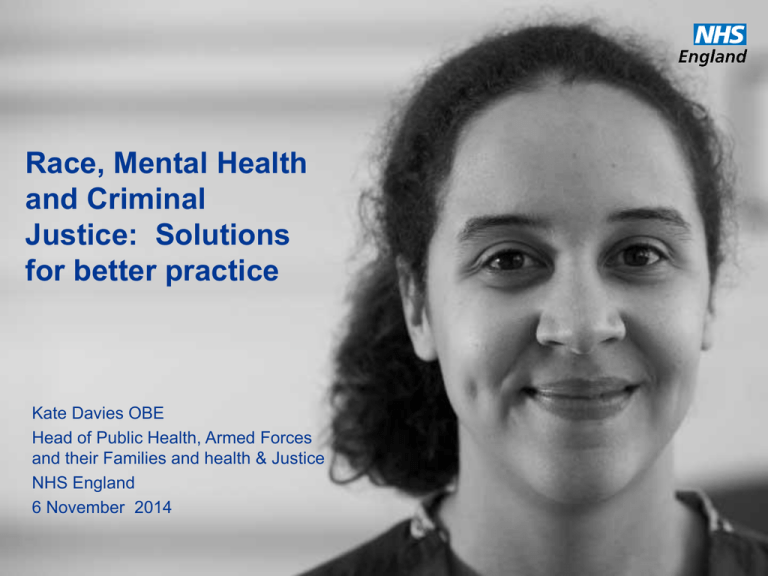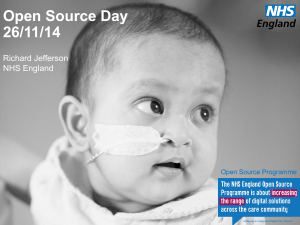
Race, Mental Health
and Criminal
Justice: Solutions
for better practice
Kate Davies OBE
Head of Public Health, Armed Forces
and their Families and health & Justice
NHS England
6 November 2014
www.england.nhs.uk
Presentation to Cover
• The role that NHS England has in commissioning services
• Update on key initiatives
• How NHS England is trying to address the over-representation of
people with mental health needs from black and minority ethnic
communities in contact with the criminal justice system
www.england.nhs.uk
2
Health & Justice Commissioning
Context
•
•
•
•
•
•
•
•
•
£472 million budget
Commissioned by 10 Lead Area Teams
One Health & Justice Clinical Reference Group
Mixed market of providers – NHS Trusts, independent and private sector
Strong mental health links including substance use
Patients are offenders, victims, detainees and families
Support reduction of offending behaviour
Strong partnership governance and reliance
Patient voice essential to monitor quality and integration of patient pathways
Through the Gate
www.england.nhs.uk
3
What We Commission?
•
NHS England is responsible for planning and commissioning health services
including the public health of people in Detained and Secure Settings across a
range of justice services’ sites:
-
Prisons;
Young Offender Institutes;
Secure Children’s Homes;
Police Custody Suites;
Immigration Removal Centres;
Liaison & Diversion Service, Police Custody and Courts;
Sexual Assault Referral Services;
- Public Health in Detained and Secure Settings
•
Key documents are ‘Securing Excellence in Commissioning for Offender Health’
published in January 2013 and Health & Justice Commissioning Intentions
published May 2014 and updated on a yearly basis
www.england.nhs.uk
4
‘During 2013/14, nearly three quarters (72% of 27,697) of detentions were of
patients in the ‘white’ ethnic group. Within the black and ethnic minority
group categories, there were more longer-term detentions of people in the
‘black or black british’ category than in any other category (these detentions
accounted for 10% or 4,012 of all longer term detentions).’
Inpatients formally detained in hospitals under the Mental Health Act 1983,
and patients subject to supervised community treatment Annual Report
2013/14.
www.england.nhs.uk
5
• Liaison & Diversion Services are committed to understanding the cohort of
individuals passing through their respective police custody suites and criminal
courts and plan to deliver services tailored to meet their needs. This will include
the recruitment of a culturally competent workforce and the development of a
wide range of referral pathways.
An example from our London wave 1 trial site:• Liaison & Diversion practitioners at Thames Magistrates’ Court identified a
number of Romanian sex workers who were regularly appearing before the court.
They usually pleaded guilty and were fined, often being returned to court for
failure to pay their fines. The practitioners forged links with a local third sector
organisation with links to the Romanian community, that assists individuals to exit
the sex industry. The L&D service makes every effort to engage with this cohort to
offer assistance at the court stage and to make onward referrals to the third
sector organisation. As a result the number of Romanian sex workers appearing
before the court has significantly reduced both the numbers of those re-offending
and those who fail to pay their fines.
www.england.nhs.uk
6
We recognise that the ageing prison population is increasing and that BME
groups are historically harder to engage in services. In the Health & Justice
Strategy we articulate our ambition to deliver patient driven commissioning to
address the overarching inequalities for this patient population and ensure we
commission for quality of delivery taking into account the particular diverse
needs of this population. This includes caring for individuals across the secure
and detained estate who have physical disabilities as well as those with
learning disabilities. There are a small but growing number of women in secure
settings who require gender specific care, not least if they are pregnant during
their sentence with a small number requiring post natal care.
“Health & Justice Strategy – NHS England”
www.england.nhs.uk
7
Why are Liaison & Diversion
Services needed?
2004/5 found that nearly
half (47%) of the offender
population had misused
alcohol in the past, 32%
had violent behaviour
related to their alcohol use
and 38% were found to
have a criminogenic need
relating to alcohol misuse,
potentially linked to their
risk of reconviction.
People in contact with the
criminal justice system are also
known to be one of the groups of
people known to be at higher risk
of suicide than the general
population.
Almost 50% of adult prisoners suffer
from anxiety and/or depression
compared with 15% of the general
population.
31% of young people (aged 13-18)
who offended (including young
people in custody and in the
community) were identified as
having a mental health need.
www.england.nhs.uk
Based on the study by
Harrington & Bailey (2005),
Chitsabesan et al. (2006)
found that 20% of young
offenders had a learning
disability
8
Liaison & Diversion Core Model
•
Early intervention in criminal justice processes
-
Identification, assessment and referral
•
Integrated model for children, youths and adults
•
Targeting a range of vulnerabilities such as
- Mental Health, Learning Disability, Substance Misuse
- Social issues, Housing, Education…
•
Provision at Police Custody and Courts
•
Hours to suit operational requirements
•
Range of referral pathways to suit identified issues
www.england.nhs.uk
9
Liaison and Diversion points of
operation
Identification
Criminal justice agencies, such as police and courts, are trained to identify
signs that an offender may have a learning disability, mental health issue,
drug and substance misuse or other vulnerability.
Screening and assessment
Specialist workforce, such as L&D practitioners with learning disability
expertise, carries out an assessment to identify the offenders needs and if
they should be referred onwards to treatment or further support. L&D
services can also call for a specialist assessment and when a specialist
expertise doesn’t exist, there is an opportunity include them into the L&D
workforce.
Referral
Offenders needing further support and treatment will be referred into
appropriate services, such as learning disability services.
www.england.nhs.uk
10
Benefits of Liaison and Diversion
•
•
•
•
•
•
•
Improved access to treatment and support services for service users,
decreasing health inequalities, improving health outcomes.
Improved use of police time and possible reduction in costly adjournments
and periods on remand
Improved efficiency as vulnerable people are identified earlier, thus reducing
the likelihood that they will reach crisis-point leading to possible reductions
in repeat arrests
Improved information on vulnerable people and their conditions to the
judiciary and police
Reductions in the time it takes to process vulnerable individuals though
police custody, by the provision of timely information to the charging /
disposal process
Reductions in court time and unnecessary adjournments, by the provision of
timely assessment information
Assurance that vulnerable people have been able to understand, and
participate appropriately in the justice system
www.england.nhs.uk
11
Predicted growth in Liaison and
Diversion services
KEY
Fully specified services
Existing L&D services
No cover
www.england.nhs.uk
12
Learning from Wave 1
MH Needs
887
443
394
Substance
Misuse
272
Alcohol
Misuse
108
155
183
Numbers of adult cases identified
with Mental Health, Substance and
Alcohol misuse needs,
(Quarter 1 data, L&D)
Trial Sites in Quarter 1:
• Returned data for 2,945 adult cases
• 296 cases involving children and young people
• Key needs (adults): mental health, substance misuse, self harm
• Key needs (children and young people): mental health, family
conflict, substances
• On average, more than 2 co-morbidities per service user
www.england.nhs.uk
13
Hearing from Liaison & Diversion
Service Users
‘It was three years ago that my
life was a living hell, it really
was and looking back now it’s
just, you know, every day is a
blessing...[Liaison and
Diversion] helped me
immensely. I don’t think I
would be alive today if I didn’t
have that intervention’. L&D
service user.
‘A [Liaison and Diversion]
professional who is able to
assess someone from a
difference and more informed
perspective makes a massive
difference improving treatment
and outcome for those in
custody’ Partnership Inspector,
Newcastle Area Command
‘Liaison and Diversion
would support people,
signpost them. Without
them you are just going
to have more people
falling through the
cracks’. Pat, L&D service
user
www.england.nhs.uk
‘Liaison and Diversion has
given me a chance to stop
reoffending for good and I
am now optimistic about
my future for the first time
that I can remember’. Jeff,
L&D service user.
14
Benefits of integrated Liaison &
Diversion and Street Triage
•
•
•
•
•
•
Demonstrates clear financial benefits to Police Forces;
A reduction in Section 136 usage;
A reduction in A&E admissions;
A reduction in 999 ambulance usage;
Earlier identification of mental health problems to ensure timely intervention,
including reducing relapses; and
Re-establish service users engagement with mental health service
www.england.nhs.uk
15
Case Study
• Black Caribbean woman aged 34, mother of 3
children, 48 offences, 8 prison sentences, crack
cocaine user, victim of domestic violence
Outcome – Liaison & Diversion service intervention
support includes women's centre and BME third sector
provider.
www.england.nhs.uk
16
Putting Patient First: Objectives
Ensure equitable access to effective treatments for the
health and justice patient cohort across England
Continue to promote continuity of care from custody to
community
www.england.nhs.uk
17
Securing Excellence in IT
Services for Health & Justice
Develop Health & Justice Information Systems to support data sharing
across health and criminal justice pathways and to improve access,
identify gaps in provision and improve quality of care.
NHS England is now leading the development of a major programme to develop and
improve Health & Justice Information Programme.
-
Phase 1, improvement of patient and information within secure
settings
Phase 2, to develop Health & Justice Information Systems across all
pathways of care including Police Custody, Liaison & Diversion and
Childrens Secure
Phase 3, to develop a stronger focus on social care and a Full
Business Case for the second generation Health & Justice
Information System
www.england.nhs.uk
18
Health and Justice - The Future
•
•
•
•
•
•
Integration with Street Triage, Liaison & Diversion and Police Custody
Healthcare
Continuity of care - Through the Gate, Custody, Prisons and Community
Street Triage Mapping. Ensuring consistency and sustainability of available
Street Triage across England
Options for future commissioning
Core Definition
Service Specification / Operating Model to support quality and patient
pathways
Health & Justice Information Management
Tackling Health Inequalities and assuring an equivalent of care for all
www.england.nhs.uk
19
Questions?
www.england.nhs.uk
20








